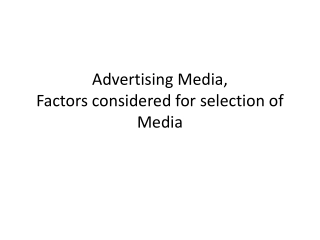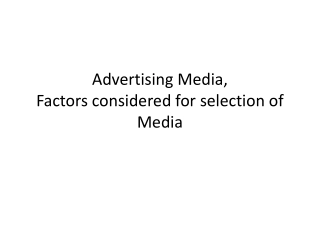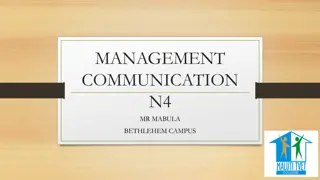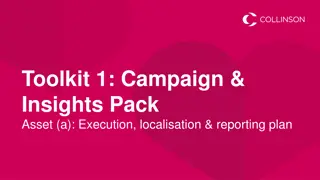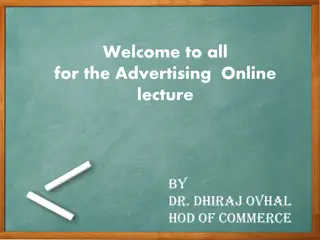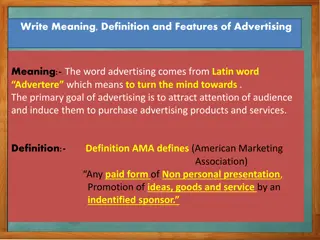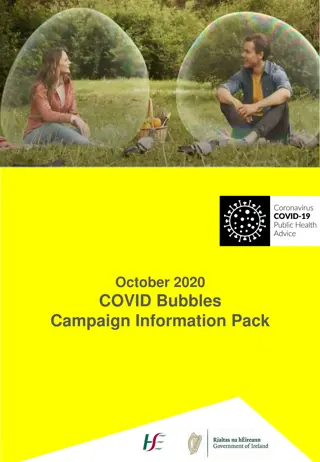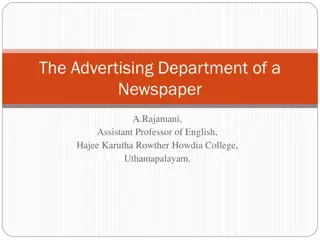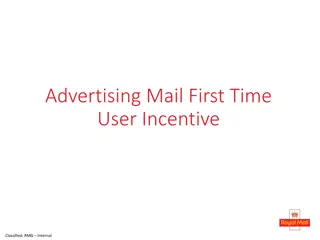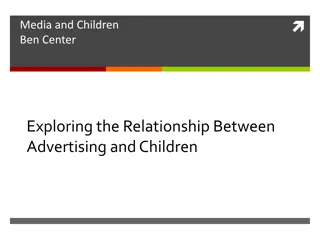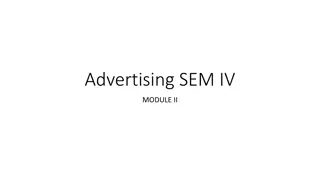Understanding Advertising Campaign Planning and Execution
Dive into the world of advertising campaigns through insightful information on creative briefs, elements, DAGMAR approach, and budget factors. Learn about the critical role of the creative brief in guiding the message execution process, the objectives and steps of DAGMAR for setting advertising goals, and the factors influencing advertising budget determination. Enhance your understanding of advertising strategies and tools to create effective campaigns.
Download Presentation

Please find below an Image/Link to download the presentation.
The content on the website is provided AS IS for your information and personal use only. It may not be sold, licensed, or shared on other websites without obtaining consent from the author. Download presentation by click this link. If you encounter any issues during the download, it is possible that the publisher has removed the file from their server.
E N D
Presentation Transcript
PLANNING ADVERTISING CAMPAIGNS
THE CREATIVE BRIEF A document that is given to the creative team to help in their planning of the message execution A creative brief includes the information such as Product information Target audience iii. Ad theme iv. Key message Advertising objectives vi. Developing brand personality vii. Media mix i. ii. v.
Creative brief is decided by advertising objectives Launching of a new product Increasing sale of existing product Covering new market segmentation Testing the market Influencing consumer attitude New use of the existing product Increasing frequency of use of the product Winning over new customers Improving packaging Changing brand image
Elements of creative brief Problem Target audience Brand positioning Brand imperatives Communication objectives Consumer insight Selling idea Supportive Creative direction Media imperatives
DAGMAR Defining advertising goals for measured advertising results Russell Cooley in the year 1961 Under the DAGMAR approach an advertising goal involves a communication task i.e. specific and measurable. DAGMAR is the model of the purchase process beginning it involves the following steps Awareness Comprehension Conviction Action
Objectives of DAGMAR Communication task Unaware Aware Comprehension Attitude Action
Specific task Written goals Measurable task Benchmark Target audience Time period
Merits of DAGMAR Facilitates sound ad planning Ensures effective communication Improves understanding Reduces subjectivity
ADVERTISING BUDGET FACTORS AFFECTING DETERMINATION OF AD BUDGET Organisational objectives Degree of market competition Stages in product life cycle Size of the market Type of the product Availability of finance Media used Size of the company Frequency of advertisement 10. Quality of advertising campaign 1. 2. 3. 4. 5. 6. 7. 8. 9.
METHODS OF SETTING AD BUDGET METHODS OF PREPARING AD BUDGET FIXED GUIDELINES METHOD TASK METHOD SUBJECTIVE METHOD Percentage of sales method Deciding the ad objective Arbitrary method Units of sales method Preparing ad plan Affordable amount method Competitors expenditure method Collecting the necessary finance Market share method Executing ad plan
MEDIA PLANNING Media planning is the process for determining for the most cost effective mix of media for achieving a set of media objectives Its basic purpose is to select the right media in order to reach the right audience so as to have a desired response COMPONENTS OF MEDIA PLANNING Marketing analysis Advertising analysis Media strategy Media schedule 1. 2. 3. 4.
NEED AND IMPORTANCE OF MEDIA PLANNING Growth of media 1. 2. Selection of media 3. Promotion of sales 4. Providing supplements 5. Suitability 6. Avoiding waste 7. Advising client
STEPS IN MEDIA PLANNING Deciding the target market for advertising 1. 2. Deciding the advertising message 3. Matching media with the target group 4. Selecting the media ( foll factors will be considered) Target audience Product Cost Message
5) Selecting specific media vehicle 6) Deciding media schedule Nature of product Nature of sales Position of product life cycle Nature and extent of competition Availability of funds 7) Implementation of media plan 8) Evaluation and follow up
MEDIA BUYING Media buying is booking time and space in media In media buying, contact will be established with the media, suitable negotiations will be made and time and space will be purchased for advertising STEPS IN MEDIA BUYING: Selection Approval of the client Contact with media Finalise plan Finalise rates
Finalise premium position Negotiations Supply materials Monitor advertisement Payment
FACTORS TO BE CONSIDERED BEFORE SELECTING A MEDIA Nature of Product Target market Media circulation and geographical coverage Media cost Media flexibility Media life Media availability Media restrictions Media image 1. 2. 3. 4. 5. 6. 7. 8. 9. 10. Advertising objectives 11. Advertising budget 12. Position of competitors
Media scheduling strategies It relates to the timing of media insertions within a specific period. Important media scheduling strategies are 1. Bursting strategy ( heavy during a particular period) 2. Burst-Hiatus-Flights( Heavy advt followed by no adv) 3. Flight strategy( distributed throughout with periodic 2) 4. Pulsing strategy ( Regular adv + low adv for a short per) 5. Seasonal strategy ( adv only during seasons) 6. Teaser step-up ( low when season starts and then picks) 7. Step down ( high when season starts then step down) 8. Steady Strategy ( fixed amt every month) 9. Alternating strategy ( adv every alt month)
Product and Slogans Product Amul Pepsi Thums Up Surf Tata Safari Asian Paints Frooti Polo Airtel Kingfisher Slogan The taste of India Yehi hain right choice baby Taste The Thunder Daag Acche hain Reclaim Your Life Har Ghar Kuchch Kahta hein Fresh N Juicy The mint with a hole Express Yourself The King of Good Times
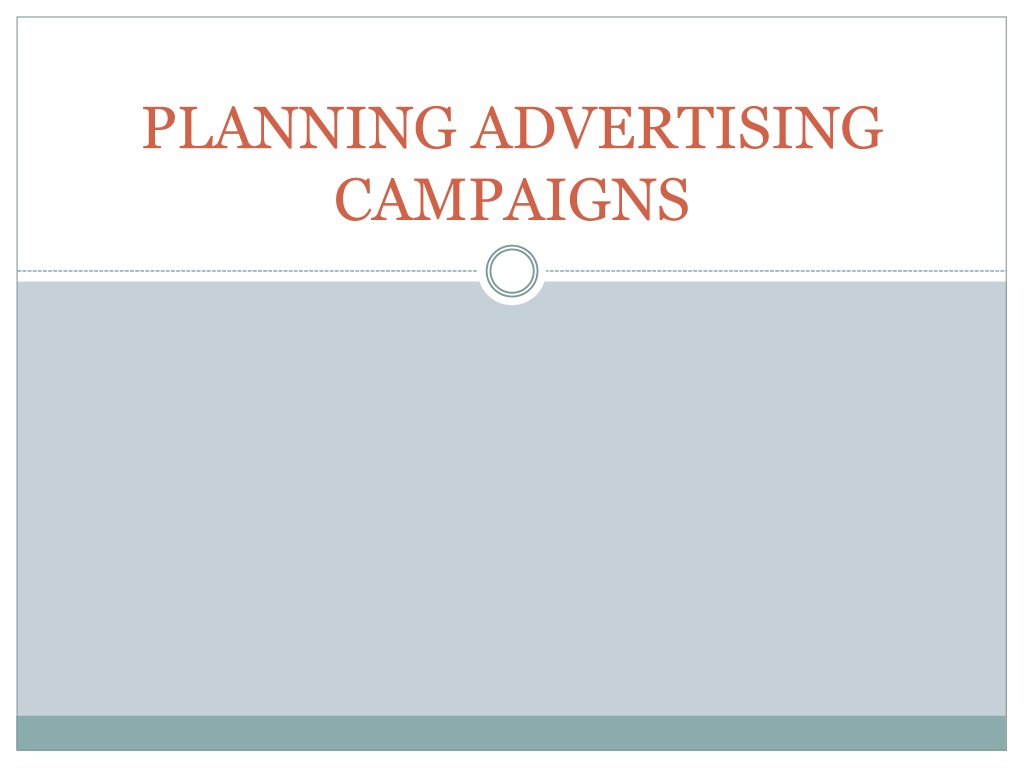
 undefined
undefined










